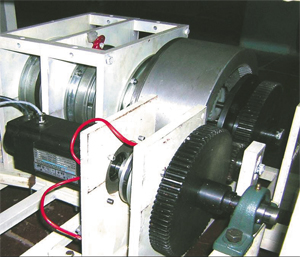The
sharply rising crude oil prices have put a technical challenge
to the automotive sector to reduce the fuel consumption.
Automotive business is looking towards electric vehicles to
reduce the dependence on oil. However, battery technology
development has been found deficient to support electric vehicles.
Fuel cell powered vehicles are being sought as permanent
solution but infrastructural demands of transporting hydrogen
currently cloud their progress. Hybrids assimilation of electric
vehicles and current IC engine based vehicles have been
shown to reduce fuel consumption by Toyota (Prius, Lexus RX-
400h), Honda (Insight, Civic) and Ford (Escape).
The fundamental difference between a hybrid
vehicle and an IC engine based (conventional) vehicle lies
in their
power train. A hybrid uses at least two prime-movers whereas
a conventional vehicle uses only one. This implies that the
transmission gearbox be able to accept two inputs rather
than one that is, it needs to be a two degrees-of-freedom mechanism.
Additionally, the gearbox needs to be compact. A planetary
gear train (PGT) is the most basic two degrees-of-freedom
mechanism. But a single PGT gearbox (as in Toyota
Prius) means that the wheels never receive the full torque
of
the prime-mover, whenever the vehicle is being run by a single
prime-mover. A compound PGT with two such basic PGTs
interconnected, then becomes a natural solution However,
most compound PGT configurations suffer from a serious
problem of recirculating power within the gearing, leading
to
adverse affect on efficiency of the system and overloading
of
gear teeth, possibly causing failure of the system.
Technology being offered
The technology developed by Prof Bharat Seth and his student
in Mechanical Engineering Department relates to one
such compound PGT meeting all the desirable features such
as: (a) harmonious addition of the power of both the primemovers
without recirculating power going to disastrous levels;
(b) operation of the engine in favourable region of its
torque-speed map; (c) a good torque multiplication at lowend
speed a characteristic extremely important considering
the increasing vehicular traffic density around the globe;
and
(d) fail safety that allows the vehicle to be operated by
any of
the prime-mover (operating alone), should the other energy
arm of the power train fail for any reason.
 Further the transmission
mechanism is implementable
in real-time, that is, one devoid of any a prior knowledge
of
drive cycle, scalable, non-myopic (a myopic operation of
vehicle
misleads into notions of lower fuel consumption based on
one round of a drive cycle) and balanced (such that, none
of
the two energy paths, electric motor and IC Engine, are
overloaded
at any time, whereby health of both the energy paths
is taken care of, at all times).
Further the transmission
mechanism is implementable
in real-time, that is, one devoid of any a prior knowledge
of
drive cycle, scalable, non-myopic (a myopic operation of
vehicle
misleads into notions of lower fuel consumption based on
one round of a drive cycle) and balanced (such that, none
of
the two energy paths, electric motor and IC Engine, are
overloaded
at any time, whereby health of both the energy paths
is taken care of, at all times).
The engine is connected to the transmission
via an
auxiliary gear set that lends it the scalability for various
types
of engines (gasoline or diesel) or for various categories of
vehicles (hatchbacks or SUVs). Additionally, this auxiliary
gear set ensures that speed longitude (on torque-speed map)
in which the engine operates is narrow and is at the lower
end
of speeds (1200-3000 RPM), a characteristic extremely
important for current (as well as those in future) Lean Burn
SI Engines and also Common-Rail Diesels.
The augmenting control architecture is simple
and
real-time since it decides based on measurable quantities
such
as battery state of charge (SOC), vehicle speed and change
in
throttle movement. The decision for gear number in next
instance is based on state of these variables in this instance,
thereby devoid of any a prior information of drive cycle
and
hence can be practically implemented. The control architecture
exhibits negligible increase in fuel consumed for 25
rounds of the New European Drive Cycle (NEDC) compared
to one round of NEDC. This implies that the IITB controller
is
non-myopic. Further, the controller alters the engine torque
contribution based on a "SOC-correction factor" which
ensures that the battery is sufficiently charged always.
The result of this unison-act of transmission
and control
architecture gives (for a Tata Indica class of vehicle of
1010 kg mass, co-efficient of drag of 0.25 frontal area
of 1.9
m2 equipped with 67 hp, 1.0 L VTEC Gasoline Engine and
10
kW permanent magnet DC motor) a consumption of 2.7 litres
per 100 km over New European Drive Cycle. On the US-EPA
drive cycle the fuel consumption is estimated to be 3.0
litres
per 100 km and on the Japanese 10-15 mode driving cycle
the
fuel consumption is only 2.3 litresper 100 km over with
a
maximum speed of 190.5 kmph.
This performance estimates compare well with
performance simulated for Toyota Prius. The invented transmission
is a generic two degrees-of-freedom transmission and is
not specific to IC Engine plus motor hybrids, hence can
be
adapted on to a two-motor architecture for fuel-cell vehicles.
Patents have been filed in India, US and European countries
and currently negotiations are on to find a suitable automotive
industry partner for prototyping and commercializing the
IIT Bombay technology.
Contact: seth@iitb.ac.in